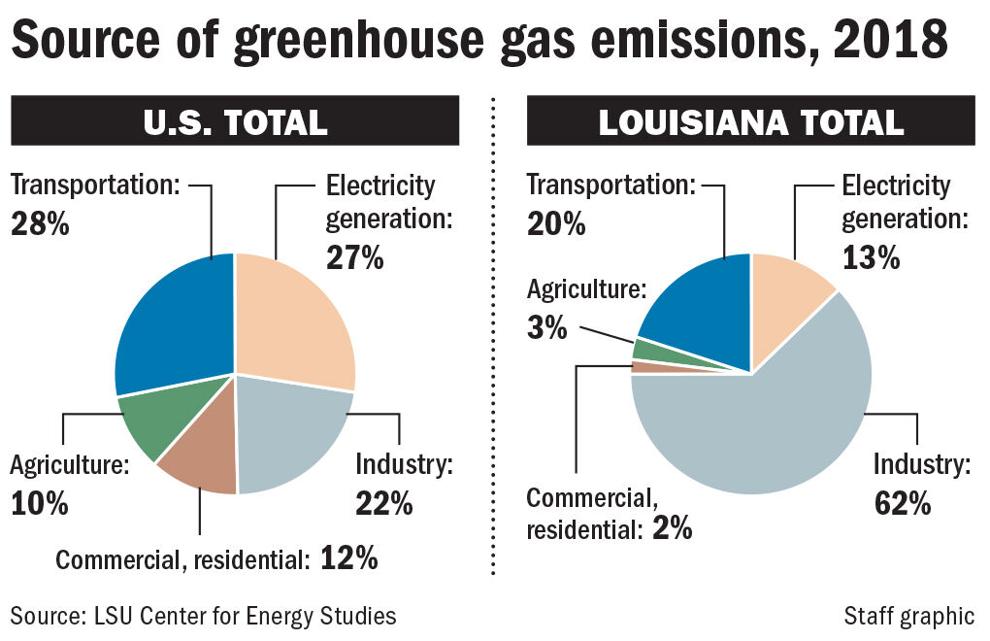
The Louisiana Climate Initiatives Task Force has met and issued the 7 ways the state will cut greenhouse gas emissions.
The Louisiana Climate Initiatives Task Force – charged with finding ways to reduce greenhouse gas emissions that lead to hotter temperatures, higher seas and more intense storms – adopted seven high-level strategies Thursday for reaching a goal of “net zero” carbon emissions in the state by 2050. The strategies target industry and other key areas of the state’s economy where carbon dioxide and other “carbon-equivalent” emissions are created. They will be used by the task force, its staff and its advisory committees to group together dozens of specific emission reduction recommendations into a plan for public comment by February. “We are really shifting to policymaking,” said Harry Vorhoff, deputy director of the Governor’s Office of Coastal Activities, who oversees the task force’s operations. “We are now getting to the heart of what we are tasked to do.”
Nola.com

Gov. John Bel Edwards’ emission reduction goals of cutting 2005’s total carbon emissions:
- 26% to 28% by 2025
- 40% to 50% by 2030
- To “net zero” emissions by 2050. A net zero level means any carbon emissions created by the state’s economy are offset by reductions or are captured and permanently stored.
In 2018, Louisiana emitted about 217 million tons of greenhouse gases, almost 2 million tons more than in 2005. The emissions represent about 4 percent of the U.S. total, said professor David Dismukes, executive director of LSU’s Center for Energy Studies. But Scott Eustis of the Healthy Gulf environmental group warned that industry expansions since 2019 and even more proposed expansions could add 100 million tons in the next 10 years to Dismukes’ 2018 estimates.
The Task Force received over 170 suggested actions including:
Slowly increasing taxes on carbon emissions
Injecting carbon dioxide emissions deep underground
Replacing carbon-related fuel sources, such as oil and natural gas, with electricity generated by solar and wind
Ensuring that workers affected by industry changes can be retrained or repurposed in other jobs
Ensuring that changes don’t affect communities of color or indigenous communities along industrial fence lines or in areas recommended for carbon capture.
The newly adopted strategies assume that technology improvements will be used by industry to help reduce emissions in manufacturing; that electric and other non-carbon fuel vehicles will become popular; that processes will be developed to capture and permanently store carbon in concrete, steel or other substances; and that natural capture of carbon by wetlands, forests and agriculture will increase.
The seven steps to cut greenhouse gas emissions are:
Clean energy transition
This requires the state to accommodate a shift towards a power grid based on clean and renewable energy, and for increasing the production and use of renewable-powered electricity. The category would likely include improvements to Louisiana’s transmission network for greater use of electricity generated from wind or solar panels. It might also include installing a state network of charging stations for electric vehicles.
Industrial decarbonization
Redesigning industrial processes and plants to be more efficient, or for industry simply to use less carbon. The idea is to mirror the reductions attained in the 1990s by the petrochemical industry in all emissions after Congress approved the Toxics Release Inventory, which required companies to publish their emission totals. In Louisiana, the petrochemical industry reduced its emissions by more than 50% percent by redesigning manufacturing processes to reduce waste.
Switching out use of carbon-based fuel in manufacturing for carbonless electricity, or non-carbon fuels such as like hydrogen.
Developing underground carbon capture and permanent storage for industrial emissions that can’t otherwise be avoided.
Improving the monitoring and certifying of plants’ progress toward carbon reduction goals.
Safe, resilient infrastructure
This calls for long-term planning for energy infrastructure to ensure it is both resilient and reliable in meeting the state’s clean energy goals.
This strategy also includes assuring that permitting for new transmission lines, power plants and pipelines is conducted equitably. Task force members Collette Pichon-Battle of the Gulf Coast Center for Law and Policy and Flozell Daniels Jr. of the Foundation for Louisiana recommended that this and the other strategies address existing inequities for low-income residents, people of color and indigenous communities suffering from past industrial location and operation decisions.
Just getting existing industries to reduce their carbon emissions might not be enough, Pichon-Battle said. “We can’t just produce our way out of this thing, just invest our way out of this thing,” she said. “In addition to a global climate crisis, our people are sick now, our communities are dying, sick because of the industries we have here now. … If we are only addressing the greenhouse gases and not the health impacts, the impacts of these industries, we are not doing our job.”
This strategy category also includes managing “legacy infrastructure,” including thousands of abandoned and shut-in oil and gas wells that are thought to be leaking methane gas, a more intense greenhouse gas than carbon dioxide. Also included is better monitoring of methane and other greenhouse gases at active wells and industrial plants, and improving leak repair requirements.
Transportation, development
Speeding adoption of alternative clean fuels and vehicles that they power
Finding ways to reduce trips for goods and services
Linking land use and transportation planning to compact development patterns that include more public transit access
Improving the efficiency of homes and commercial buildings, and their resilience to the effects of climate change.
Natural and working lands, wetlands
This strategy recognizes that agriculture, forestry and coastal and inland wetlands contain plants that can capture large quantities of carbon from the atmosphere, and thus offset some of the state’s human-caused emissions.
Inclusive low-carbon economy
Identify how to strengthen clean energy education, to assist in implementing other strategies
Identify low-carbon businesses and industries that will expand the state’s job markets and economic investments.
Collaborate and partner
Look for ways to maximize federal funding in support of carbon reduction efforts
Position Louisiana as a climate emissions reduction leader in national and regional dialogues
Ensure state agencies, local governments, the private sector and regulated communities work together to meet the reduction goals
Assure that the other strategies incorporate recommendations and needs of all communities, including both recognized and unrecognized indigenous communities.
The final report is due in January 2022 with strategies and action items due by August. The Task Force is to look at consequences in August and October and figure out if they will actually work. I December the report will be fine tuned.
There is now a potential road map which I hope will stay even with changes in government.



